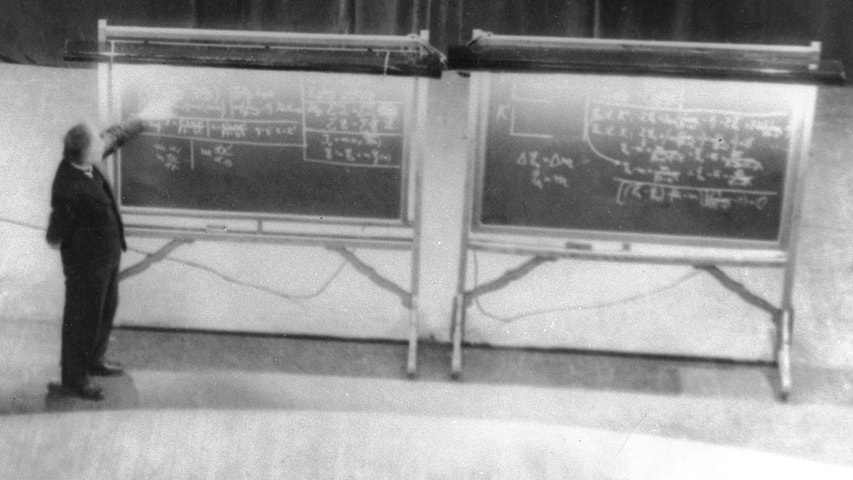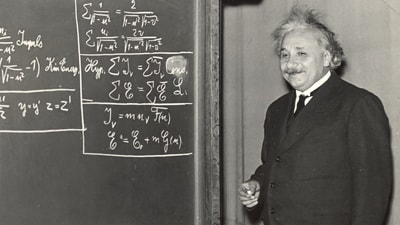Iconic Images

Courtesy of The Jacob Rader Marcus Center of the American Jewish Archives, Cincinnati, Ohio. Americanjewisharchives.org. This is the only known image of Einstein with a variant of his famous equation,
Albert Einstein was already a scientific celebrity when he arrived in Pittsburgh to deliver a lecture on Dec. 28, 1934 at the Carnegie Institute of Technology, now known as Carnegie Mellon University.
His proof of the mass-equivalency theorem, commonly referred to by the equation E = mc2, which explained the theory of special relativity, was the topic of his Josiah Gibbs Lecture of the American Mathematical Society (AMS).
The brief visit to Pittsburgh produced the only known photograph of Einstein with a variant of his famous equation: a foggy, nearly indecipherable photo taken from a balcony of the Little Theater (now known as CMU's Kresge Theater), showing Einstein in front of a blackboard with the equation.

Albert Einstein
Although his lecture was just one of many events at the AMS conference, press coverage focused almost exclusively on Einstein. The event was one of his first major U.S. public appearances.
"People clambered to see Einstein's lecture because he was one of the world's first rock-stars," said Gregg Franklin, a professor of physics at CMU. "In his words, Einstein's famous E = mc2 equations tells us that 'mass and energy are both manifestations of the same thing — a somewhat unfamiliar conception for the average mind.'"
On the 81st anniversary of his lecture, the photograph is still a topic of discussion, said David Topper, a Pittsburgh native and a professor of the History of Science at the University of Winnipeg.
Topper is the author of several books about Einstein, including a forthcoming book "Einstein for Anyone: A Quick Read" (Vernon Press).
The Gibbs Lectures, which were established by the AMS in 1923 and continue today, are intended for a general audience. While Einstein delivered his lecture in English — a rarity — and went less than an hour, he did not simplify the language, which Topper said was typical for an Einstein lecture.
Most of the 350 attendees in the audience were AMS members, though a small portion of tickets were available to the general public. According to some reports, scalpers were selling tickets for as much as $50 and almost a thousand hopeful attendees showed up to the theater.
Aside from photographic evidence and press coverage, most of what's known of Einstein's visit comes from the first-hand written account of his chaperone, Leon Watters, who accompanied Einstein. His account offers insights into the scientific community of the time and Einstein's populist nature.
One example is from Leo Scanlon, co-founder of the Amateur Astronomers' Association of Pittsburgh, who invited Einstein to visit the organization's exhibition at the Mellon Institute. Though he had a tight schedule, meeting with the Amateur Astronomers was one thing Einstein made an effort to see in Pittsburgh.
"He had a thing about amateurs, whom he respected as much as professionals," Topper said. "He liked average people."